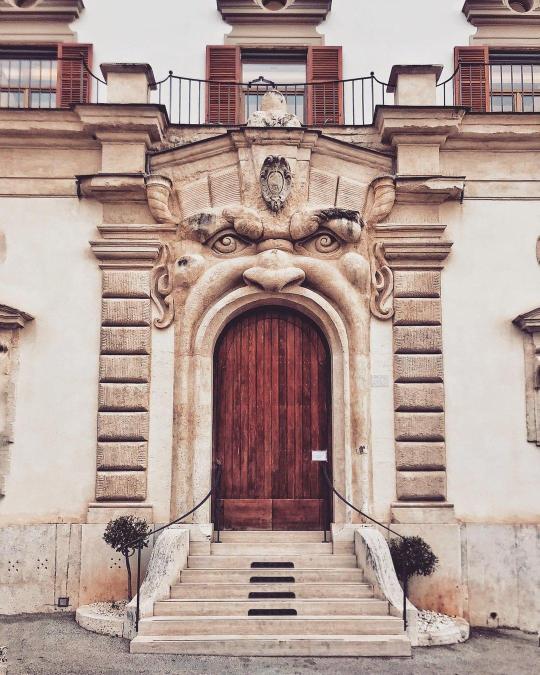#Palazzo Zuccari
Text

Palazzo Zuccari, Federico | Rome Italy.
1K notes
·
View notes
Photo
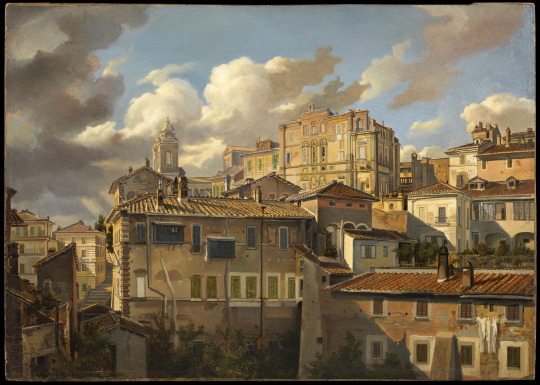
View of Pincio and Palazzo Zuccari, Rome
Eugen Napoleon Neureuther (German; 1806–1882)
ca. 1836–37
Oil on cardboard panel
Nationalmuseum, Stockholm, Sweden
#Pincio#Pincian Hill#Rome#Eugen Napoleon Neureuther#Neureuther#city views#cityscapes#Roman views#Roman hills#German art#German artists#German paintings#Palazzo Zuccari#Roman palazzo#palazzo#palazzi#buildings#roofs#washing#clouds#19th century#1830s#19th-century art#19th-century German art#19th-century German artists#facades#German painters#Eternal City#Roman palazzi#Nationalmuseum
83 notes
·
View notes
Text
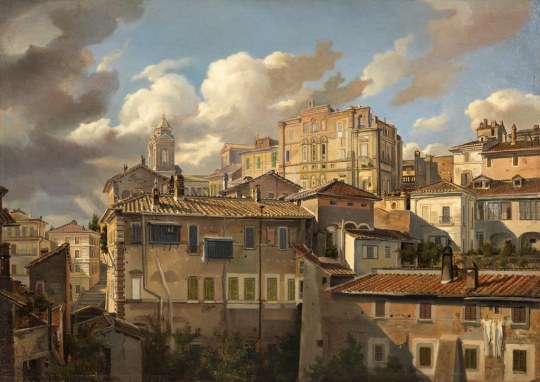
Eugen Napoleon Neureuther - View of the Pincio and Palazzo Zuccari, Rome (ca. 1836-37)
138 notes
·
View notes
Photo
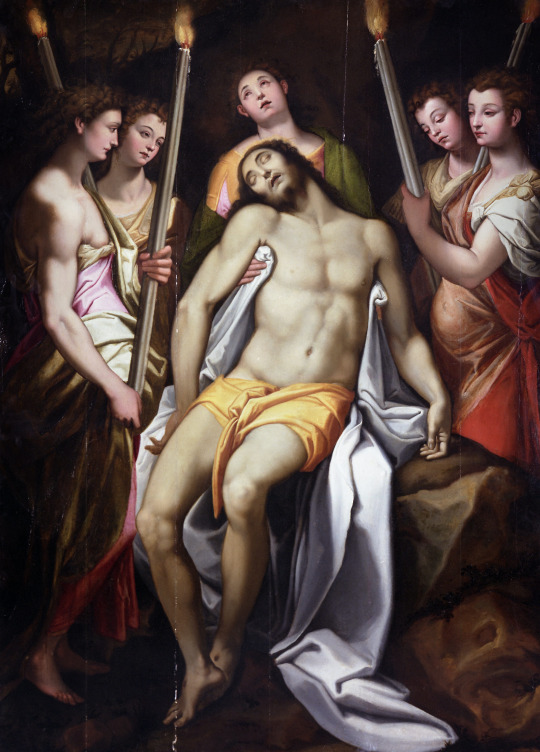
Taddeo Zuccari (Italian, 1529–1566)
Pietà with torchbearers, c.1560-66
Born in Urbino, the painter is considered the main representative of Italian Mannerism. He was Federico”Ts older brother, went to Rome aged 14 and soon became a very popular artist with wealthy clients and was able to establish his own business as a fresco painter. He received commissions from Pope Julius III and Paul VI together with Prospero Fontana, was active in the Villa Giulia and was allowed to paint the representative rooms in the Palazzo Farnese in Caprarola, which can probably be considered his principal work. He also decorated the Sala dei Fasti in the Palazzo Farnese in Rome. Zuccari attained a fortune which allowed him to build a palace in Rome. Due to his importance, he was buried near Raphael’s tomb in the Pantheon in Rome.
There are several other versions of the present work, for example in the Galleria Borghese, Rome (canvas, 232 x 142 cm.) or in the Galleria Nazionale delle Marche, Urbino (281 x 154 cm., image no. FAB60351). Upon closer examination, certain aspects suggest that the work was not fully completed before Zuccari’s death in 1666. When giving the painting a title, the wax candles were misunderstood on various occasions as “Attributes of the Passion of Christ”. The Farnese cardinal is said to have conveyed this idea for the depiction with candles to the painter. The famous biographer Giorgio Vasari already mentioned the Zuccari. The importance of the painting is also demonstrated by its distribution as a copperplate engraving.
The painting is considered a protected Italian cultural asset and is located in Italy.
#art#art history#european history#european art#italian art#classical art#peita#Pietà#pieta with torchbearers#Jesus Christ#The Son of God#Jesus#Christ#christianity#christentum#christendom#fine art#fine arts#oil painting#italian#italy#mediterranean#europe#italian peninsula#catholic art#catholic#roman catholic#roman catholic art#traditional art#Taddeo Zuccari
39 notes
·
View notes
Text
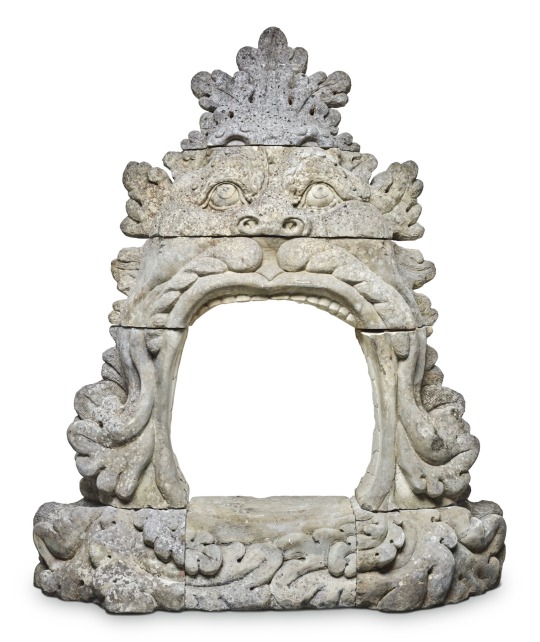
Continental, late 19th/early 20th century
Fireplace
Carved stone
The unusual yet impressive design of this fireplace recalls the enormous 'Hell Mouth' created for Vicino Orsini between 1550 and 1584 in the Parco dei Mostri, Bomarzo. The grotesque mask was a popular form used in Italy as early as the late 16th century as can been seen at The Palazzo Zuccari, in Rome, featuring a front door and two windows surrounded by an imposing face with furrowed brows. The gaping mouth of a huge monster representing the entrance to Hell, two further examples stand in the Villa Torre in Fumane and another in the gardens of the Villa Aldobrandini, near Frascati.
Sotheby’s
34 notes
·
View notes
Text
Bibliotheca Hertziana - Istituto Max Planck per la storia dell'arte, Juan Navarro Baldeweg- Enrico Da Gai, 2003 - 2012
Dal sito Open House Roma: "La Bibliotheca Hertziana riassume tutte le caratteristiche proprie alle più alte realizzazioni. Una magnifica architettura contemporanea che restituisce una lettura sofisticata delle preesistenze storico-artistiche. Audaci soluzioni strutturali e un'ingegneria elaborata appositamente per la salvaguardia dei resti della villa di Lucio Licinio Lucullo, rinvenuti nel corso degli scavi, hanno richiesto una cantierizzazione modello studiata per il centro storico di Roma. Un progetto complesso reso possibile grazie a un'esemplare collaborazione tra committenza e studi professionali europei. L'ingresso scenografico su Via Gregoriana è dominato dal "Mascherone", portale antropomorfo che un tempo consentiva l'accesso al giardino dell'adiacente Palazzo Zuccari."
Grazie mille, come ogni anno, al grande impegno di @openhouse.roma
#ohr23 #openhouseroma #bibliothecahertziana #istitutomaxplanck #baldeweg #JuanNavarroBaldeweg #enricodagai #dagaiarchitetti #palazzozuccari #roma #archiporn #architecture #architects #urban #quiriters #igerslazio #yallersroma #volgoroma #archidaily #architettura #architetti #architexture #architecturelovers #urbanlovers #archilovers #designlovers #fiafers #fiaferslazio
instagram
3 notes
·
View notes
Text
PALAZZO ZUCCARI E LA “BOCCA/PORTA” DEL MOSTRO
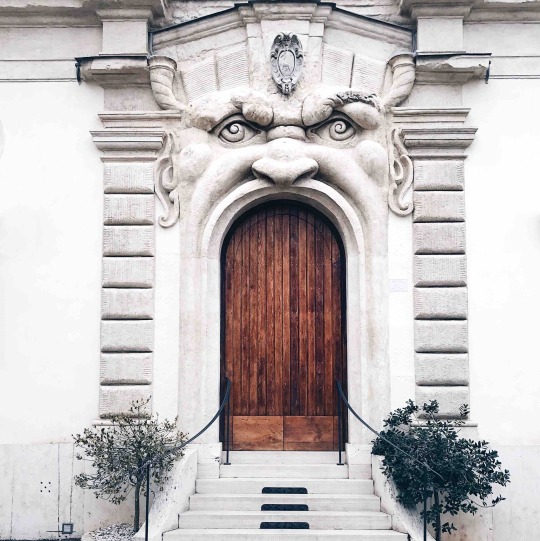
Hai mai visitato il Bosco Sacro di Bomarzo? Se ci sei già stato, sicuramente saprai paragonare una delle porte più “paurose” di Roma con il mostro di Bomarzo. L’architetto Federico Zuccari infatti, per realizzarlo, si ispirò propriamente al Parco dei Mostri di Bomarzo.
In Via Gregoriana al civico 30 sorge un palazzo molto particolare, il cui ingresso è permesso solamente tramite questa porta…che in realtà è rappresentata dalle fauci spalancate del grande mostro!
La porta in questione, con la testa e gli occhi del mostro che vi aspettano entrare, incute quasi terrore anche solo per potercisi scattare una foto vicino, con la paura di essere inghiottiti o risucchiati dalla “bocca/porta” realizzata in legno.
Stessa cosa per quanto riguarda la cornice del portone e le finestre del palazzo, riprendono le sembianze inquietanti del mostro stesso.
E tu avresti coraggio di entrare? Non hai curiosità di sapere cosa c’è all’interno da visitare con attenzione?
Per passare tra attimi di terrore e curiosità e visitare l’interno delle grandi fauci del mostro , puoi soggiornare in uno dei nostri B&B Roma adatto a te! Ci trovi nel B&B Roma centro, a pochi passi dai principali monumenti (e anche da Trastevere!); potrai trovare B&B and breakfast Roma centro.
#bedandbreakfastrome#bedandbreakfastroma#guesthouseroma#guesthouserome#affittacamereroma#piazzanavona#piazzadispagna#piazzadelpopolo#campodeifiori#locandaparlamento#relaisparlamento#locandadipiazzadelpopolo#lanticalocandadellorso#domusester#palacerome
2 notes
·
View notes
Photo

Artist: View of Pincio and Palazzo Zuccari, Rome Eugen Napoleon Neureuther (German; 1806–1882) ca. 1836–37 Oil on cardboard panel Nationalmuseum, Stockholm, Sweden https://www.instagram.com/p/CeYiFcEt8nk/?igshid=NGJjMDIxMWI=
2 notes
·
View notes
Text
youtube
Silvius [Sylvius] Leopold Weiss [Weiß] was a German composer and lutenist, the master lutenist of the 18th century and one of the greatest players of all time. He was born into a lute-playing family: his father Johann Jakob (1662-1754) and brother Johann Sigismund (c1690-1737) were also lutenists of distinction. Silvius Leopold and first learned the instrument from his father.
In 1706, Silvius Leopold Weiss made his professional debut in the Breslau court, in which his family served. Weiss' extraordinary talent gained the attention of Elector Johann Wilhelm, dedicatee of Arcangelo Corelli's Op. 6 and an intelligent patron of music. Weiss served in Wilhelm's court in Düsseldorf for the next two years, and his earliest known compositions date from this time.
In 1708 he was engaged by the former Polish queen, Maria Casimira, as a musician in the service of her son Prince Alexander Sobieski, who travelled to Rome to join her there in that year. Weiss left Düsseldorf for Rome and resided in the Zuccari palazzo until 1714, absorbing new Italian styles firsthand and touring with the Prince to various courts. By the time of the Prince's death, Weiss' reputation was already well established, and he spent the next several years touring the continent and taking fixed employment only briefly. In Prague he met the prominent Bohemian lutenist Count Johann Anton Losy, whose work had a considerable impact. After Losy's death, Weiss would write a memorial Tombeau that remains one of most eloquent works.
In 1714 Silvius Leopold Weiss returned to Germany and briefly served at the Hesse court at Kassel. In 1717 he first played at Dresden, and in 1718, weary of wandering, he decided to settle into a lucrative post offered him at the court of Dresden in the famous orchestra of the Saxon elector and King of Poland, August the Strong. Though this did not prevent him from travelling on occasion, Dresden would serve him as home base for the rest of his life. Attempts to dislodge Weiss from Dresden made by representatives of the Vienna Court, including princely sums of money offered, went ignored. Weiss is known to have met with the violinist Franz Benda in 1738.
At his death in 1750, Silvius Leopold Weiss was 66 years of age. He was, and still is, regarded as the greatest of all lutenists, and the instrument fell into decline within two decades of his death. An evaluation by the Markgrafin Wilhelmine de Bayreuth, sister of Frederick II of Prussia and herself a composer, would serve well as epitaph; "(Weiss) excels so much in playing the Lute that no one has ever matched him, and those who will come after him will only be left with the glory of imitating him." Sylvius Weiss' son Johann Adolph Faustinus Weiss succeeded him as a Saxon court lutenist.
Silvius Leopold Weiss was one of the most important and most prolific composers of lute music in history and one of the best-known and most technically accomplished lutenists of his day. He wrote around 600 pieces for lute, most of them grouped into 'sonatas' (not to be confused with the later classical sonata, based on sonata form) or suites, which consist mostly of Baroque dance pieces. Weiss also wrote originally extensive repertory of chamber music, lute duets, and concertos, but only the solo parts have survived; in every case the parts that accompany the solo lute are lost. Some of his "Suonate" (Weiss' own term) for solo lute, which have come down to us in a variety of tablature manuscripts, are missing their preludes, which were usually improvised. Seventy suites, however, are known in their entirety; most last about 20 to 25 minutes in performance. As a composer, Weiss shows extraordinary originality; his suites stand comparison with those of J.S. Bach. Only one of the suites, No. 49 in B flat minor, appeared in print during Weiss' own lifetime; his work was not intended for amateur players but for virtuosi whose skills approached his own. A modern printed edition of Weiss' complete works has been underway since 1980.
Weiss' music is characterised by a unique understanding of the capabilities of his instrument, its strengths and its weaknesses; like J.S. Bach's, it represents the culmination of a high Baroque style a little at odds with the more progressive aspirations of his younger contemporaries. Weiss was also in demand as a teacher. His many aristocratic pupils included the young Frederick the Great and his sisters Wilhelmena (later Margravine of Bayreutlt) and Anna Amalia, Princess of Prussia, and his otter pupils included the lutenists Adam Falckenhagen and Johann Kropfgans.
Silvius Leopold Weiss' skill as a player and accompanist was legendary, as were his powers of improvisation. In this he was even compared with J.S. Bach, though it is doubtful whether they actually formally competed in improvisation, as the following account by Johann Friedrich Reichardt describes:
"Anyone who knows how difficult it is to play harmonic modulations and good counterpoint on the lute will be surprised and full of disbelief to hear from eyewitnesses that Weiss, the great lutenist, challenged J. S. Bach, the great harpsichordist and organist, at playing fantasies and fugues."
Weiss and J.S. Bach had been in all probability well known to one another even before they actually met. In later life, Weiss became a friend of Wilhelm Friedemann Bach. During 1739 Weiss stayed in Leipzig for four weeks, together with W.F. Bach and his own pupil Johann Kropfgans, and he visited the J.S. Bach house frequently; Johann Elias Bach, J.S. Bach's personal secretary, reports that the music he heard then was 'extra-special'. He wrote that that "we heard some very fine music when my cousin from Dresden [Wilhelm Friedemann Bach] came to stay for four weeks, together with the famous lute-player Mr. Weiss." J.S. Bach's Suite for violin and harpsichord in A major BWV 1025, recently identified as an arrangement of one of Weiss' lute sonatas, may owe its origin to one of these legendary meetings.
It is often suggested that J.S. Bach's, no slouch at the lute himself and an enthusiast of the hybrid lute-harpsichord, may have written his lute music (BWV 995-1000, 1006a) for Weiss, or even commissioned by him, but there is no concrete evidence for this, despite the musical and personal links between the two men. J.S. Bach was connected with a circle of professional and amateur lute players in Leipzig, and Weiss, as a fine composer, is unlikely to have felt the need to ask J.S. Bach to write for him. On the on the other hand, J.S. Bach would undoubtedly have known Weiss' music through playing it on his lute-harpsichord, probably in transcriptions like the one he made as the basis for the BWV 1025 arrangement. It is hard to believe that Weiss did not return the compliment in some way.
0 notes
Photo

Urbino (Marche). Church of the Holy Spirit (1554) and surroundings. The small sanctuary in via Bramante (at the height of the Largo Clemente XI - Albani, the present statue is however dedicated to Celestine V) stands in a particularly interesting area of the historic center of Urbino. In the post of 29/12 last we saw other details of the long road, such as the Botanical Garden and other appurtenances of San Francesco. The temple can be traced back to the Congregation of the Holy Spirit, existing in Urbino since 1398. In the same street, right in front of the Botanical Garden, stands the ancient Palazzo Albani (15th century), closed between via T. Viti and via del Balestriere, not to be confused with the new Palazzo Albani mentioned in the post of 2.12 us, however belonging to the same family as the first pope mentioned above. The palace is home to a museum and humanistic university institutes. Shots: a) altar of the church of Santo Spirito with the Pentecost of one of the Zuccari. The single hall contains several canvases within wooden frames; b) entrance-side part of the barrel vault of the single hall of the church; c) altar-side part of the barrel vault. In a total of fifteen boxes the 4 prophets and the 7 gifts of the Holy Spirit are represented; d) final stretch of via Bramante towards Porta Santa Lucia; e) via del Balestriere with the side pertaining to Palazzo Albani on the left; f) via Timoteo Viti, with its wall of Palazzo Albani (always on the left). #shots #university #post #confused #details #interesting #stretch #gifts #urbino #marche #holyspirit #sanctuary #albania #dedicated #botanical #single #frames #side #travel #traveling #visiting #instatravel #travelling #tourism #instatraveling #travelgram #travelingram #massimopistis #sovVERSIvi #estremisti Information for the purchase of my new book "Extremists!": The book at a cost of 12.00 euros (120 pages), can be ordered in the bookstore (ISBN 978-88-591-5719-9 - Editore Aletti) or requested to the e-mail [email protected] with additional postage (currently 1.28 euros - fold of books). https://www.instagram.com/p/CnKrKnCOPOB/?igshid=NGJjMDIxMWI=
#shots#university#post#confused#details#interesting#stretch#gifts#urbino#marche#holyspirit#sanctuary#albania#dedicated#botanical#single#frames#side#travel#traveling#visiting#instatravel#travelling#tourism#instatraveling#travelgram#travelingram#massimopistis#sovversivi#estremisti
1 note
·
View note
Text
Quale futuro per le Accademie, ISIA, Conservatori di musica ?
Quale futuro per le Accademie, ISIA, Conservatori di musica ?
AFAM: Quale futuro per le Accademie, ISIA, Conservatori di musica ?
È il tema del convegno organizzato al Senato della Repubblica a palazzo Giustiniani – Sala Zuccari. L’iniziativa vuole offrire una riflessione e un confronto sul sistema dell’Alta Formazione Artistica, Musicale e Coreutica – AFAM nell’ottica di una più ampia crescita culturale e economica del Paese.
L’incontro si è svolto lunedì…
View On WordPress
0 notes
Link
0 notes
Text
Gaetano Nastri sul Femminicidio: bene Meloni su maggiori risorse
Gaetano Nastri sul Femminicidio: bene Meloni su maggiori risorse
Di seguito le parole del Senatore questore di Fratelli d’Italia Gaetano Nastri, a margine della presentazione della Relazione conclusiva della Commissione d’inchiesta sul femminicidio alla presenza della Premier Giorgia Meloni e del Presidente del Senato Ignazio La Russa, avvenuta nella sala Zuccari di palazzo Madama.
(more…)

View On WordPress
0 notes
Text
Il Sindacato dei giornalisti a tinte calabresi
Il Sindacato dei giornalisti a tinte calabresi
In Senato, a Palazzo Giustiniani in Sala Zuccari, tenuto a battesimo il nuovo sindacato dei giornalisti italiani. Ma non solo giornalisti. Figec vuole essere infatti il sindacato di tutti gli operatori dell’informazione italiana, della comunicazione, dei media, dell’editoria, dell’arte e della cultura.
Partiamo dal nome. Si chiama Figec, che sta per Federazione Italiana Giornalismo, Editoria e…

View On WordPress
0 notes

